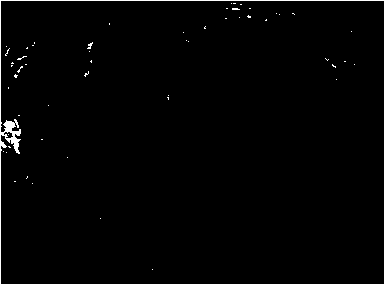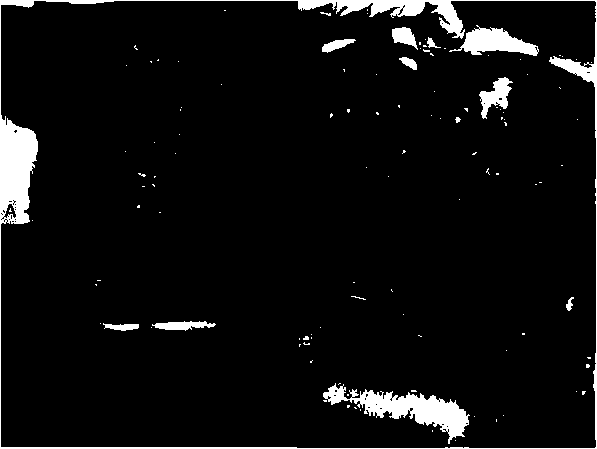Anti-adhesion biological membrane and preparation method thereof
A biofilm and anti-adhesion technology, which is applied in the field of tissue engineering medical biomaterials, can solve the problems of inability to suppress inflammation and achieve good physical barrier anti-adhesion, good biocompatibility, and not easy to fall off.
- Summary
- Abstract
- Description
- Claims
- Application Information
AI Technical Summary
Problems solved by technology
Method used
Image
Examples
Embodiment 1
[0031] Step 1. Disinfection treatment: wash the flake SIS with the mucous membrane layer and lymph nodes removed with purified water until there is no dirt, soak it in an aqueous sodium hydroxide solution with a concentration of 0.5mol / L for half an hour, and then wash it with purified water to pH neutral;
[0032] Step 2. Decellularization and antigen removal treatment: soak the sterilized SIS in a trypsin solution with a concentration of 1 mg / mL for half an hour, then wash it with purified water, and place it in a DNA hydrolase solution containing 25 U / mL and 40 U / mL α-galactosidase enzyme solution for 4 hours, and finally washed 10 times with purified water;
[0033] Step 3: Composite hyaluronic acid: Cut the SIS processed in step 2 to 3×4cm, soak it in a hyaluronic acid solution with a concentration of 20 mg / mL for 2 hours, take it out and freeze-dry it in vacuum to obtain a compounded hyaluronic acid SIS diaphragm;
[0034] Step 4. Sterilization treatment: after packagi...
Embodiment 2
[0038] Step 1. Disinfection treatment: wash the flake SIS with the mucous membrane layer and lymph nodes removed with purified water until it is free of dirt, soak it in an aqueous sodium hydroxide solution with a concentration of 3 mol / L for 2.5 hours, and then wash it with purified water to pH neutral;
[0039] Step 2. Decellularization and antigen removal treatment: soak the sterilized SIS in a trypsin solution with a concentration of 1mg / mL for half an hour, then wash it with purified water and place it in a solution containing 10U / mL DNA hydrolase and 30U / mL Soak in the α-galactosidase enzyme solution for half an hour, and finally wash 5 times with purified water;
[0040] Step 3: Composite hyaluronic acid: Cut the SIS processed in step 2 to 4×6 cm, soak it in a hyaluronic acid solution with a concentration of 5 mg / mL for half an hour, take it out, and vacuum freeze-dry it to obtain a compounded hyaluronic acid Acidic SIS diaphragm;
[0041] Step 4. Sterilization treatm...
Embodiment 3
[0045] Step 1. Disinfection treatment: wash the sheet-shaped SIS with the mucous membrane layer and lymph nodes removed with purified water until it is free of dirt, soak it in an aqueous potassium hydroxide solution with a concentration of 1 mol / L for 1 hour, and then wash it with purified water to pH neutral;
[0046] Step 2. Decellularization and antigen removal treatment: soak the sterilized SIS in a trypsin solution with a concentration of 3 mg / mL for 2 hours, wash with purified water, and place in a solution containing 15 U / mL of DNA hydrolase and 35 U / mL Soak in the α-galactosidase enzyme solution for 2 hours, and finally wash 7 times with purified water;
[0047] Step 3: Composite hyaluronic acid: cut the SIS processed in step 2 to 5×5 cm, soak it in a hyaluronic acid solution with a concentration of 10 mg / mL for 1 hour, take it out and vacuum freeze-dry to obtain a compounded hyaluronic acid SIS diaphragm;
[0048] Step 4. Sterilization treatment: packaging the SIS ...
PUM
| Property | Measurement | Unit |
|---|---|---|
| Thickness | aaaaa | aaaaa |
| Concentration | aaaaa | aaaaa |
| Concentration | aaaaa | aaaaa |
Abstract
Description
Claims
Application Information
 Login to View More
Login to View More - R&D
- Intellectual Property
- Life Sciences
- Materials
- Tech Scout
- Unparalleled Data Quality
- Higher Quality Content
- 60% Fewer Hallucinations
Browse by: Latest US Patents, China's latest patents, Technical Efficacy Thesaurus, Application Domain, Technology Topic, Popular Technical Reports.
© 2025 PatSnap. All rights reserved.Legal|Privacy policy|Modern Slavery Act Transparency Statement|Sitemap|About US| Contact US: help@patsnap.com



